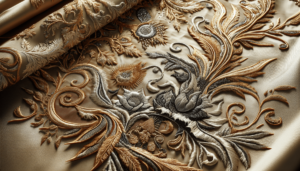The Impact Of Embroidery On Brand Perception In The Luxury Market
Have you ever considered how the small details on a luxury garment can shape your perception of an entire brand? Embroidery, in the realm of luxury fashion, is one of those exquisite details that can elevate a brand’s identity beyond mere fabric and thread. It’s not just about aesthetics; it’s about legacy, craftsmanship, and the story embroidered into every piece.

This image is property of pixabay.com.
The Significance of Embroidery in the Luxury Market
A Touch of Timeless Artistry
In the luxury market, embroidery isn’t just decoration—it’s an art form. It has been passed down through generations and perfected over centuries in various cultures worldwide. When you purchase a luxury item adorned with intricate embroidery, you’re buying into that rich history and heritage. The meticulous handwork that goes into each stitch signifies the brand’s dedication to quality and craftsmanship.
Embroidery as a Brand Signature
Many luxury brands use unique embroidery techniques or designs as their signature, making their products instantly recognizable. Think about brands like Chanel or Gucci; their iconic embroidery elements are not just accessories but integral parts of their brand identity. When you see that distinctive embroidery, you immediately connect it with the brand’s ethos and prestige.
Elevating Consumer Experience
Embroidery adds an element of tactile and visual luxury that can enhance your overall experience with a product. This sensory connection can foster a deeper emotional bond with the brand. The texture and complexity of embroidered patterns make each piece feel more personalized and exclusive, adding to the overall luxurious experience.
The Historical Context of Embroidery in Luxury
Early Examples of Embroidered Luxury
Historically, embroidered clothing was limited to royalty and the elite. It was a symbol of wealth and status, given the time-consuming and skill-intensive process involved. Ancient civilizations like the Egyptians and Chinese have rich traditions of embroidery that were often used to denote social standing.
European Renaissance and the Rise of Couture
In Europe, especially during the Renaissance, embroidered garments became even more intricate and elaborate, signifying both power and wealth. The era gave rise to haute couture, where designers started incorporating detailed embroidery to create unique, one-of-a-kind pieces for the affluent.
Modern-Day Revival
Today, embroidery is seeing a resurgence in the luxury market. Modern designers are combining traditional techniques with contemporary designs, creating a bridge between the old and the new. This revival reflects a growing appreciation for craftsmanship in an era of mass production and fast fashion.

This image is property of pixabay.com.
The Role of Craftsmanship
Hand vs. Machine Embroidery
One main distinction in luxury embroidery is between hand and machine embroidery. Hand embroidery is a labor-intensive process that requires exceptional skill and patience. Each stitch is placed with care, making every piece unique. Machine embroidery, while faster, lacks the soul and uniqueness of hand-crafted work. In luxury fashion, hand embroidery is considered a higher form of art and craftsmanship, providing a significant differentiating factor.
The Skill of Artisans
Luxury brands often employ skilled artisans who have mastered the art of embroidery through years of practice. These artisans bring a level of expertise and passion to their work that is evident in the final product. Their skill can transform simple fabric into a masterpiece, thereby enhancing the brand’s reputation for quality and exclusivity.
Innovation in Embroidered Designs
While maintaining traditional techniques, luxury brands also innovate with new materials and designs. For example, they might use unconventional threads, metallics, or even incorporate 3D elements into their embroidery. This constant evolution keeps the brand relevant while honoring the age-old traditions of the craft.
Psychological Impact of Embroidery on Consumers
Perception of Value and Exclusivity
Luxury embroidered items are often perceived as more valuable and exclusive compared to non-embroidered counterparts. This perception is due to the skill, time, and attention to detail required in the embroidery process. As a consumer, when you see an embroidered piece, you immediately associate it with higher quality and exclusivity.
Emotional Connection
Embroidery can also create an emotional connection with the consumer. The intricate designs and the story behind each piece can elicit feelings of nostalgia, admiration, or even a sense of belonging to a particular cultural or social group. This emotional connection can be a strong motivator for brand loyalty.
The Allure of Customization
Many luxury brands offer customized embroidery services, allowing you to personalize your items. This level of customization adds an extra layer of appeal, making the item uniquely yours. Whether it’s a monogram, a special date, or a custom design, this personalized touch can create a lasting bond between you and the brand.

This image is property of pixabay.com.
Case Studies of Iconic Embroidered Luxury Brands
Chanel
Chanel is a prime example of a brand that uses embroidery to enhance its luxury status. The brand’s iconic tweed jackets often feature intricate hand-embroidered details. This not only adds to the aesthetic appeal but also signifies the brand’s commitment to maintaining traditional craftsmanship.
Gucci
Gucci has made bold, embroidered designs a significant part of its modern identity. From floral patterns to embroidered animals, these intricate details have become synonymous with Gucci’s flamboyant and eclectic style. The brand’s willingness to push boundaries while maintaining high craftsmanship standards has set it apart in the luxury market.
Dior
Dior is another brand that has seamlessly integrated embroidery into its luxury offerings. The brand often uses embroidery to add a touch of elegance and sophistication to its pieces. For instance, the brand’s haute couture gowns often feature stunning, hand-embroidered designs that make each piece a work of art.
The Economic Impact on Luxury Brands
Increased Costs and Pricing
The intricate nature of embroidered work naturally increases production costs. These costs are typically passed on to the consumer, resulting in higher-priced items. However, the perceived value and exclusivity of embroidered luxury items often justify the price increase.
Here’s a simple comparison:
| Factor | Non-Embroidered Items | Embroidered Items |
|---|---|---|
| Material Cost | Lower | Higher |
| Production Time | Shorter | Longer |
| Craftsmanship | Basic to Moderate | High |
| Perceived Value | Moderate | High |
| Price | Moderate to High | High to Very High |
Consumer Willingness to Pay
Consumers in the luxury market are generally willing to pay a premium for embroidered items due to the factors mentioned above: craftsmanship, exclusivity, and emotional connection. Brands that master the art of embroidery can command higher prices without alienating their customer base.
Brand Differentiation
Embroidery can act as a significant differentiator in a crowded luxury market. With numerous brands competing for consumer attention, those that excel in unique, high-quality embroidery can set themselves apart. This differentiation is crucial in establishing a strong brand identity and loyal customer base.

Sustainable and Ethical Considerations
The Ethical Labor Behind Embroidery
Given the labor-intensive nature of embroidery, it’s essential for luxury brands to ensure ethical labor practices. Employing artisans at fair wages and providing them with a safe working environment should be a priority. Ethical labor not only benefits the workers but also enhances the brand’s reputation.
Sustainable Materials
An increasing number of luxury brands are incorporating sustainable materials into their embroidered pieces. By using organic threads, natural dyes, and eco-friendly fabrics, brands can appeal to the environmentally conscious consumer. Sustainability in luxury fashion is not just a trend but a long-term shift towards responsible production.
Cultural Appropriation vs. Appreciation
Another important consideration is the cultural significance of certain embroidery techniques and patterns. Brands must strike a balance between drawing inspiration and practicing cultural appropriation. Working with local artisans and giving credit to the cultural origins of specific designs can show genuine appreciation.
Future Trends in Luxury Embroidery
Technology and Embroidery
While hand embroidery remains a pinnacle of luxury, technology is also making inroads. Advances in digital embroidery techniques allow for more complex and precise designs. This doesn’t necessarily replace handwork but can be used to complement it, creating innovative and intricate pieces.
Fusion of Traditional and Modern
The future of embroidery in the luxury market lies in the fusion of traditional techniques with modern aesthetics. By blending age-old craftsmanship with contemporary design, brands can continue to appeal to a broader audience while preserving the art form’s heritage.
Personalized and Interactive Embroidery
Imagine wearing a garment whose embroidery changes color or pattern based on your body temperature or environment. While this may sound futuristic, it’s where the future of embroidery could be headed. Personalized and interactive embroidery will add a new dimension to luxury fashion, making items even more unique and engaging.

Conclusion
Embroidery has a profound impact on brand perception in the luxury market. It’s not merely an adornment but a testament to craftsmanship, history, and quality. Whether it’s the rich history that each stitch tells, the unmatched craftsmanship of skilled artisans, or the emotional connection it fosters with consumers, embroidery plays an indispensable role in elevating a brand’s identity.
So, next time you come across an intricately embroidered luxury item, take a moment to appreciate the story it tells. It’s more than just fabric and thread—it’s a piece of art that carries the weight of tradition, skill, and passion. Through embroidery, luxury brands not only enhance their aesthetic appeal but also deepen their emotional connection with consumers, making it a timeless element in the world of high fashion.



